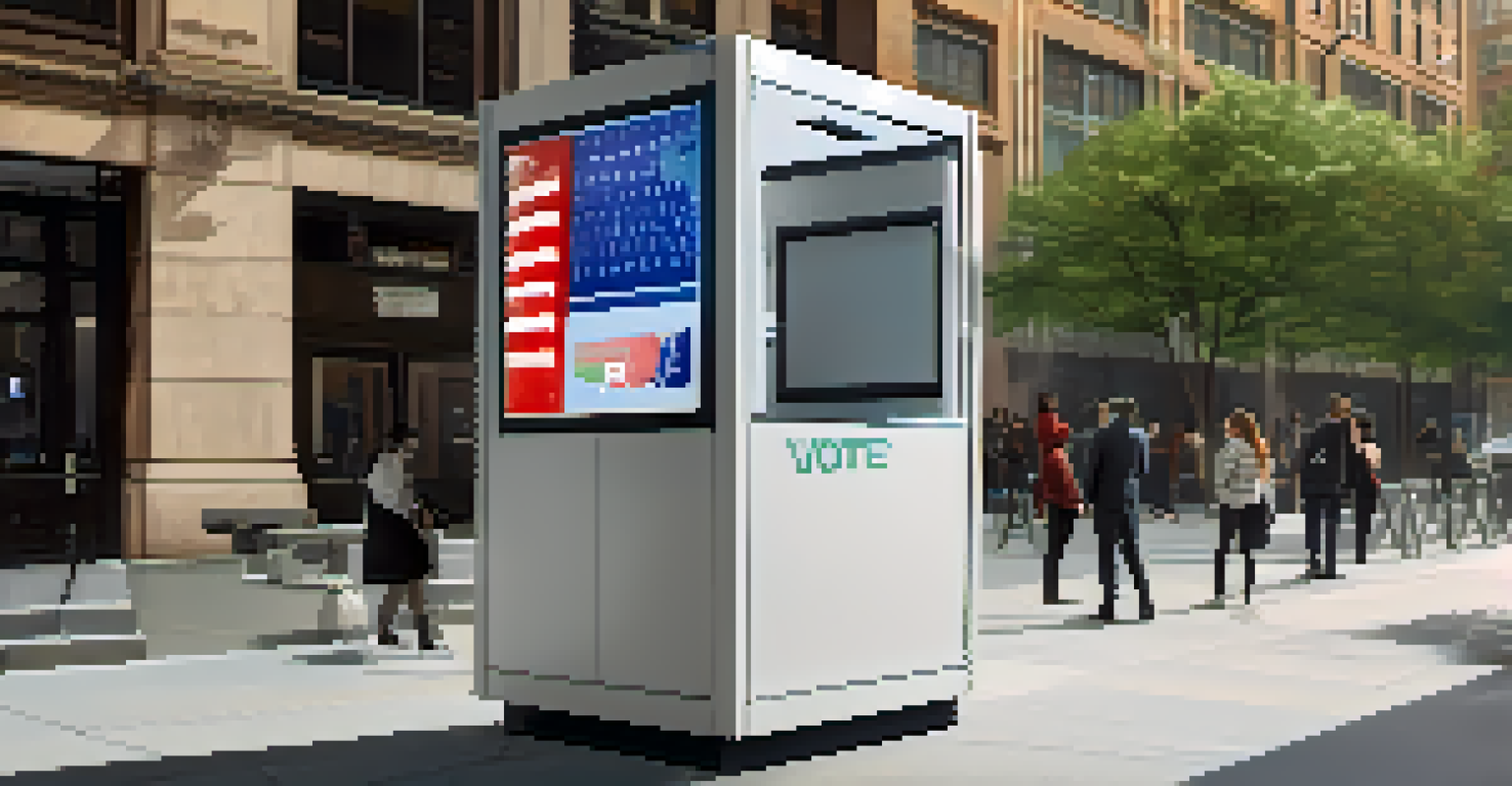The Future of Civic Engagement: Technology's Role in NYC

The Evolution of Civic Engagement in NYC
Civic engagement in New York City has come a long way, evolving from traditional town hall meetings to a more digital landscape. Historically, residents gathered in person to voice their concerns and ideas, fostering community bonds. However, as technology advanced, these interactions began to shift online, allowing for broader participation. This transition has opened doors for many New Yorkers who may have faced barriers in traditional settings, such as time or mobility constraints.
Civic engagement is not just a right, it is our responsibility as citizens to be actively involved in our communities.
In recent years, we’ve witnessed a significant increase in online platforms aimed at making civic engagement more accessible. Websites and apps like NYC's own '311' system allow residents to report issues and request services with just a few taps on their smartphones. This ease of access encourages residents to participate actively in their communities, fostering a sense of ownership and responsibility. As we move forward, it’s essential to recognize how these technological innovations can enhance civic participation.
It's clear that technology has not only transformed the way we engage but also who gets to engage. As more people get involved, the city can benefit from diverse perspectives that represent its vibrant population. This evolution raises an important question: how can we ensure that technology continues to serve as a bridge rather than a barrier in civic engagement?
The Role of Social Media in Civic Participation
Social media platforms have become powerful tools for civic engagement, allowing New Yorkers to connect, organize, and advocate for change. Platforms like Twitter and Facebook enable users to share their thoughts on local issues, mobilizing others to join the conversation. This instant connectivity fosters a sense of community, as people can rally around shared interests or concerns. However, it also comes with challenges, such as the spread of misinformation and polarization.

One notable example is the use of social media during local elections, where candidates and community organizations leverage these platforms to reach voters. Campaigns can share updates, respond to questions, and create targeted ads to engage specific demographics. This two-way communication not only informs citizens but also invites them to participate in the democratic process actively. It’s a reminder that civic engagement isn’t just about voting; it’s also about being informed and involved.
Digital Shift in Civic Engagement
Civic engagement in NYC has evolved from in-person meetings to digital platforms, enhancing accessibility for residents.
Despite its advantages, it's crucial for users to critically assess the information they encounter on social media. As digital citizens, we must cultivate media literacy skills to discern fact from fiction. By doing so, we can ensure that social media remains a constructive space for civic discourse rather than a breeding ground for division.
Online Voting: A Step Towards Inclusivity
The idea of online voting has gained traction as a way to increase voter turnout and make the electoral process more accessible. In a bustling city like New York, where residents often juggle demanding schedules, online voting could offer a convenient alternative to traditional methods. This shift could particularly benefit young voters and those with disabilities, who may face challenges in reaching polling places. By embracing technology, we can help foster a more inclusive voting environment.
The future of civic engagement depends on our ability to make technology work for all residents, ensuring that everyone has a voice.
Pilot programs in various jurisdictions have demonstrated the potential effectiveness of online voting. For example, several states have experimented with secure online systems that allow voters to cast their ballots from the comfort of their homes. These initiatives have shown promise in increasing engagement, especially among demographics that historically vote at lower rates. Yet, implementing such systems in a city as large as New York requires careful planning to ensure security and accessibility.
While the prospect of online voting is exciting, it also raises important questions about security and privacy. Protecting voters’ personal information and ensuring the integrity of the election process must be paramount. Moving forward, ongoing discussions about the balance between accessibility and security will be crucial as we consider the future of voting in NYC.
Data-Driven Decision Making in Civic Engagement
The use of data in civic engagement can transform how city officials understand and respond to community needs. By analyzing data collected from various sources, such as surveys, social media, and city services, leaders can identify trends and areas for improvement. For instance, if data shows an increase in reports about inadequate public transportation in a specific neighborhood, city planners can prioritize resources accordingly. This data-driven approach empowers residents by ensuring their voices are heard and acted upon.
Moreover, open data initiatives allow citizens to access and analyze city datasets, promoting transparency and accountability. When residents can see how decisions are made and where resources are allocated, they are more likely to engage in the political process. This transparency fosters trust between the government and its citizens, reinforcing the idea that everyone has a stake in their community. It also encourages innovative solutions as residents can use the data to propose ideas and initiatives.
Social Media's Civic Role
Social media empowers New Yorkers to connect and advocate for local issues, though it also poses challenges like misinformation.
However, the reliance on data also underscores the need for equity in its collection and interpretation. It’s vital to ensure that all voices are represented in data analyses, particularly those from underserved communities. As we harness the power of data in civic engagement, we must remain vigilant about inclusivity and equity to truly reflect the diverse makeup of New York City.
Civic Tech Startups: Innovating Engagement Strategies
Civic tech startups are emerging as key players in enhancing civic engagement strategies. These innovative companies develop tools and platforms that empower citizens to connect with their local governments and each other. From apps that facilitate neighborhood discussions to platforms that streamline community feedback, civic tech is making it easier for residents to get involved. This entrepreneurial spirit is a testament to the growing recognition of technology's role in fostering meaningful civic participation.
For example, platforms like Nextdoor encourage neighbors to connect and share information about local events, safety concerns, and community resources. By creating a space for residents to communicate directly, these tools help strengthen community ties and promote collective action. Similarly, startups focused on improving access to public services are working to ensure that even the most marginalized voices can be heard. This is a significant step towards a more engaged and informed citizenry.
As these startups continue to innovate, it’s essential for them to collaborate with local governments to maximize their impact. By working together, civic tech companies and city officials can create solutions that address real community needs. This partnership can lead to more responsive governance and a stronger, more engaged populace ready to tackle the challenges of the future.
The Importance of Accessibility in Civic Tech
As technology plays an increasingly vital role in civic engagement, ensuring accessibility for all is paramount. This includes creating platforms and tools that cater to individuals with diverse abilities, languages, and backgrounds. For instance, websites and apps should comply with accessibility standards, allowing everyone to participate in civic discussions and activities. By prioritizing inclusivity, we can ensure that no one is left behind in the digital age.
Moreover, offering language support in civic tech applications can help bridge communication gaps in a multilingual city like New York. By providing resources in various languages, we empower more residents to engage with local issues and participate in decision-making processes. This commitment to accessibility not only strengthens our communities but also enriches the diversity of perspectives in civic engagement.
Enhancing Inclusivity Through Tech
Ensuring accessibility in civic tech is crucial for empowering all residents to participate in community discussions and decision-making.
Ultimately, fostering an inclusive environment in civic tech is not just a moral obligation; it's a smart strategy for building a more engaged and informed citizenry. When everyone can access and contribute to civic discussions, we create a richer tapestry of ideas and solutions. The future of civic engagement in NYC depends on our ability to make technology work for all residents, ensuring that everyone has a voice.
Looking Ahead: The Future of Civic Engagement in NYC
As we gaze into the future, the potential for technology to reshape civic engagement in New York City is both exciting and daunting. With the rapid pace of technological advancements, we can expect new tools and platforms to emerge, further transforming how residents connect with their communities and governments. However, with these innovations come responsibilities to ensure that they are used ethically and equitably. Our commitment to fostering inclusivity and accessibility will determine the success of these initiatives.
Community-driven approaches will continue to play a crucial role in shaping the future of civic engagement. By encouraging collaboration between local governments, civic tech startups, and residents, we can create a dynamic ecosystem that thrives on innovation and active participation. This collaborative spirit can lead to more responsive governance, where officials are tuned in to the needs and desires of their constituents. The future of civic engagement should be one where every voice is valued and heard.

In conclusion, technology's role in civic engagement is only set to grow in the coming years. By embracing these changes and striving for inclusivity, we can build a future where civic engagement thrives in New York City. Together, we can harness the power of technology to create a more informed, engaged, and connected community—one that reflects the rich diversity of our great city.